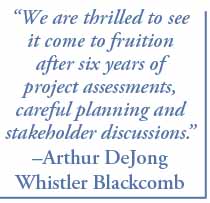
Whistler (BC), Canada — Construction has begun on a renewable energy project that will offset the total annual energy consumption at Whistler Blackcomb. The Fitzsimmons Creek Hydro Project, located beneath the Peak 2 Peak gondola under construction and entirely within the B.C. ski and snowboard resort’s operating area, will produce 33.5 gigawatt hours of hydro electricity per year — the equivalent of powering the ski resort’s winter and summer operations including 38 lifts, 17 restaurants, 269 snowguns and countless other buildings and services.
The 7.5 megawatt hydro project is being developed by Fitzsimmons Creek Hydro Limited Partnership, part of a joint venture between Innergex Renewable Energy and Ledcor Power Group.
“Whistler Blackcomb is a strategic partner in the project, their efforts to facilitate the water rights licensing and coordinate the various stakeholders allowed the project to move ahead,” says Jamie Horner, Project Manager for the Fitzsimmons Creek Hydro Project. Whistler Blackcomb is directly involved in the construction and environmental stewardship of the project.
 “This project marks a new chapter in Whistler Blackcomb’s history book and will become the bedrock of our enactment on climate change,” says Arthur DeJong, Whistler Blackcomb’s Mountain Planning and Environmental Resource Manager. “Climate change is our number one threat, and our efforts to address this issue can be categorized under the headings conservation and renewable energy generation. While we have a solid track record on conservation, this is our first major renewable energy project and we are thrilled to see it come to fruition after six years of project assessments, careful planning, and stakeholder discussions. We can now firmly step forward in producing a renewable energy project that makes sense, and to help us move ever-closer to our goal of achieving a net zero footprint within our operating area.”
“This project marks a new chapter in Whistler Blackcomb’s history book and will become the bedrock of our enactment on climate change,” says Arthur DeJong, Whistler Blackcomb’s Mountain Planning and Environmental Resource Manager. “Climate change is our number one threat, and our efforts to address this issue can be categorized under the headings conservation and renewable energy generation. While we have a solid track record on conservation, this is our first major renewable energy project and we are thrilled to see it come to fruition after six years of project assessments, careful planning, and stakeholder discussions. We can now firmly step forward in producing a renewable energy project that makes sense, and to help us move ever-closer to our goal of achieving a net zero footprint within our operating area.”
The Fitzsimmons Creek area provides the ultimate conditions for a successful small hydro electric project. The creek has an abundance of water, the necessary vertical drop, it is not a major fish-bearing stream, nor is the creek used recreationally within the project area. The creek is already tied extensively into Whistler Blackcomb’s snowmaking system, and much of the area that will need to be developed runs along an existing access road for Whistler Blackcomb’s operations. The project will not require above-ground hydro lines and the lines can travel underground in a previously disturbed area.
The Fitzsimmons Creek Hydro Project will have a single turbine with a capacity of 7.5 megawatt, and the power generated by the project will be sold to British Columbia’s hydro electric utility, BC Hydro. The project will be among the first to use BC Hydro’s Standing Offer Program that was created under the BC government’s 2007 Energy Plan.
In addition to being a significant milestone in Whistler Blackcomb’s environmental policy, the project also supports the Resort Municipality of Whistler’s 2020 plan, which lays out a vision for success through 2020 based on the three pillars of sustainability; economic, social and environmental. “From what I understand about the project, it supports Whistler2020’s Energy Vision of providing local sources of low impact, renewable energy, says Dan Wilson, Whistler2020 Energy Task Force Member. “It is an early stepping stone towards Whistler2020’s goal of a sustainable Whistler.”
Ledcor CMI Limited is the contractor for the project, and is the major contractor for other hydro projects in the Sea to Sky corridor. Construction is currently underway and the project is expected to be operational by 2010. A series of open houses will be conducted in the fall of 2008 offering tours of the construction site and providing an opportunity for the community to learn more about the project.